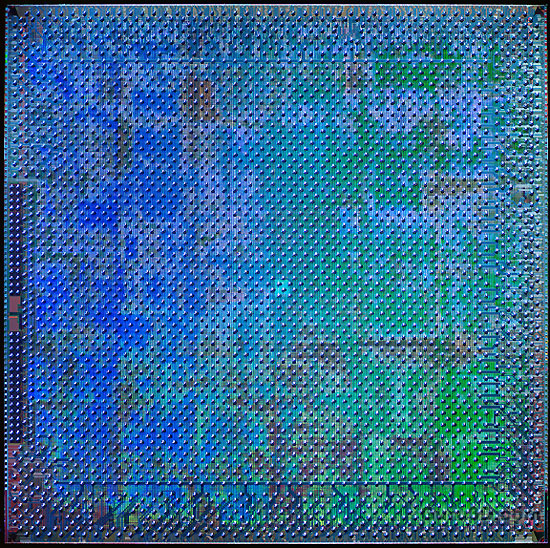Page 2 - Into the heart of the beast
Into the heart of the beast
G70... if I'm not mistaken you must have heard about that a couple of times by now, right? It's NVIDIA new internal codename scheme. No more NVxx people. NVIDIA has changed over the years and there's much more diversity in their product line. Their mainboard chipset for example is called C19 for the Intel Edition nForce 4 platform. C is for Chipset and G is short for Graphics. G70, Graphics Series 7... 7800 in this case. Nothing complex about that huh? Well, I explained. You have no idea how many emails I received over codenames and what they actually mean.

G70 thus is the GeForce 7800 GTX. At this very moment, this is the only model released in the 7x00 range. I'm not doubting there will be many new products later on. But this 7800 GTX is the new flagship, the fastest available. And I know that many of you are wondering if will there be an AGP version. To be honest, at this time and moment NVIDIA has no plans for it. That doesn't mean it'll never happen though as they can use the well known bridge chip (High Speed Interconnect) and make it AGP compatible. Face it, AGP is becoming history.
| $ffffffffff --------------------------------------------------- $ffffffffff Display adapter information $ffffffffff --------------------------------------------------- $0000000000 Description : NVIDIA GeForce 7800 GTX $0000000001 Vendor ID : 10de (NVIDIA) $0000000002 Device ID : 0091 $0000000003 Location : bus 5, device 0, function 0 $0000000004 Bus type : PCIE $000000000f PCIE link width : 16x supported, 16x selected |
$ffffffffff --------------------------------------------------- $ffffffffff NVIDIA specific display adapter information $ffffffffff --------------------------------------------------- $0100000000 Graphics core : G70 revision A1 (24x1,8vp) $0100000001 Hardwired ID : 0090 (ROM strapped to 0091) $0100000002 Memory bus : 256-bit $0100000003 Memory type : DDR (RAM configuration 07) $0100000004 Memory amount : 262144KB $0100000005 Core clock : 303.750MHz $0100000006 Memory clock : 630.000MHz (1260.000MHz effective) |
Let's dig a little deeper into the chip. As you know the number of transistors in the actual silicon gives us a nice idea about performance. Intel's new Pentium 4 6xx series for example have 169 million transistors. The GeForce 6800 already had 222 million transistors. And now the GeForce 7800 GTX has 302 million transistors, crazy huh? It's being manufactured on a 0.11 micron fabrication process.
| What is a shader ? |
| What do we need to render a three dimensional object; 2D on your monitor? We start off by building some sort of structure that has a surface, that surface is being built from triangles and why triangles? They are quick to calculate. How's each triangle being processed? Each triangle has to be transformed according to its relative position and orientation to the viewer. Each of the three vertices the triangle is made up of is transformed to its proper view space position. The next step is to light the triangle by taking the transformed vertices and applying a lighting calculation for every light defined in the scene. At last the triangle needs to be projected to the screen in order to rasterize it. During rasterization the triangle will be shaded and textured.And now we finally get to the stage where we can explain Shaders. Vertex and Pixel shaders allow developers to code customized transformation and lighting calculations as well as pixel coloring functionality. Each shader is basically nothing more than a relatively small program executed on the graphics processor to control either vertex or pixel processing. |
So what are the major advantages over the Series 6 6800 Ultra? Well, feature wise we are looking pretty much at the same technology. There are a few differences though, which we'll get into later. Overall the 7800 GTX is mostly about increased efficiency and higher performance over the previous generation product.
Normally we see little steps though, yet with 24 pipes, 8 vertex units, a huge transistor count combined with some nice internal hardware optimizations, the boost in performance is noticeable.
- 256-bit GeForce 7800 GTX (430MHz clock)
- 302 Million transistors
- 8 Vertex Shading Units
- 24 Pixel pipelines
- 256MB 256-bit 1.6ns (8x32) GDDR3 Memory (630MHz clock - 1.26 GHz effective)
- PCI Express x16 Compatibility (PCI Express Compliant)
- Integrated NVIDIA TV Encoder (HDTV, S-Video, Composite,)
- Integrated NVIDIA VIVO (S-Video, Composite,)
- Dual DVI-I Connectors
- 38.4 GB per second memory bandwidth
- NVIDIA PureVideo Technology
- DVD + HDTV Decode assist up to 1920x1080p resolution
- Integrated Dual 400MHz RAMDACs
- 1 Dual Link TMDS DVI Connector
- 1 Single Link TMDS DVI Connector
- NVIDIA Digital Vibrance Control (DVC) 3.0
- Support for Microsoft Video Mixer Renderer (VMR)
- Advanced adaptive de-interlacing
The first reaction when you look at the architecture of the G70 chip is that it is a prolonged 6800 core. Not entirely true, NVIDIA made some stern changes inside where all that magic happens. According to NVIDIA the internal pipelines were from top to bottom redesigned to make sure there was lower and thus better latency.
This increased performance is for each and any clock cycle. Not only that though, according to NVIDIA the vertex units have been rebuilt to increase geometric performance, a new texture engine accelerates texture processing and there are a number of other things that guarantee better performance. All in all the focus on this design was to increase its shader supremacy as this is where the future of gaming must be found.
 Yes, yes... the core of the G70 silicon, 302 Million transistors on there.
Yes, yes... the core of the G70 silicon, 302 Million transistors on there.
